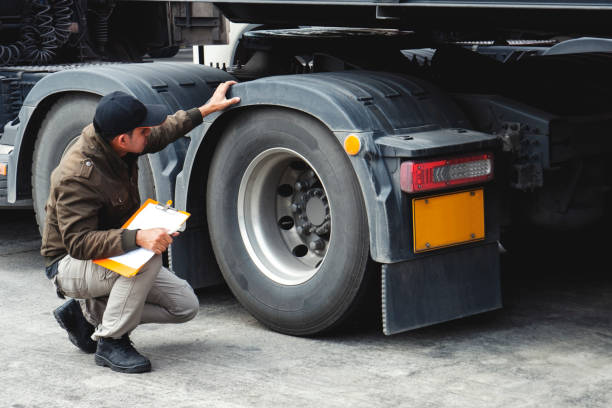Semi-trucks are the backbone of the transportation industry, hauling heavy loads across long distances. However, to keep these massive vehicles moving safely and efficiently, it is crucial to maintain their tires. Tire performance has a direct impact on the truck’s handling, fuel efficiency, safety, and overall operational costs. Understanding the various factors that influence semi-truck tire performance can help drivers, fleet managers, and owners maximize the lifespan of their tires, reduce downtime, and ensure safer journeys.
In this article, we will explore the key factors that affect semi-truck tire performance and provide tips on how to mitigate these challenges. By paying close attention to these aspects, you can improve tire longevity and ensure your truck operates smoothly on the road.
1. Tire Pressure
One of the most critical factors affecting semi-truck tire performance is tire pressure. Tires that are either over-inflated or under-inflated can cause several issues, including:
- Increased Tire Wear: Under-inflated tires cause excessive wear on the outer edges of the tire, while over-inflated tires wear down the center tread more quickly.
- Reduced Fuel Efficiency: Improper tire pressure increases rolling resistance, which forces the engine to work harder, leading to higher fuel consumption.
- Poor Handling and Stability: Incorrect tire pressure can affect the handling and stability of the truck, especially when making sharp turns or driving on uneven terrain.
- Increased Risk of Blowouts: Under-inflated tires are more prone to overheating, which can lead to blowouts, a dangerous situation for both the driver and other road users.
To ensure optimal performance, it is essential to regularly check and maintain proper tire pressure. Semi-truck tires should be inflated according to the manufacturer’s specifications, which can be found in the truck’s manual or on the tire placard.
2. Tire Tread Depth
Tire tread depth plays a significant role in maintaining traction and ensuring safe driving, especially in adverse weather conditions such as rain or snow. Tread depth refers to the grooves in the tire that allow water to escape, preventing hydroplaning and improving grip on the road.
- Reduced Traction: Tires with shallow tread depth have less grip, which can lead to skidding and loss of control, particularly on wet or icy roads.
- Longer Stopping Distances: Worn tires take longer to stop, increasing the risk of accidents.
- Increased Tire Wear: Uneven tread wear can result in poor tire performance and shorten the tire’s lifespan.
Regularly inspecting the tread depth of your semi-truck tires is crucial. The recommended minimum tread depth for commercial truck tires is 4/32 of an inch for front tires and 2/32 of an inch for rear tires. If your tire tread falls below these limits, it is time to replace the tires to ensure safety and optimal performance.
3. Tire Alignment
Tire alignment refers to the angle at which the tires make contact with the road. Proper alignment ensures that all tires are working in unison, providing maximum stability and control. Misaligned tires can cause several issues, including:
- Uneven Tire Wear: When tires are not properly aligned, certain areas of the tire tread wear down faster than others, leading to premature tire replacement.
- Poor Handling: Misaligned tires can cause the truck to pull to one side, making it more difficult to maintain control of the vehicle.
- Increased Fuel Consumption: Misalignment increases rolling resistance, which forces the engine to work harder and burns more fuel.
To avoid these problems, regular tire alignment checks are recommended, especially if you notice uneven tire wear or if the truck starts pulling to one side. Proper alignment ensures that your tires wear evenly and perform at their best.
4. Load Weight and Distribution
The weight and distribution of the load carried by a semi-truck significantly impact tire performance. Overloading or uneven weight distribution can lead to several issues:
- Excessive Tire Wear: Overloading increases the pressure on the tires, causing them to wear out faster, particularly on the rear axles that bear the brunt of the weight.
- Reduced Handling: An unevenly distributed load can affect the truck’s balance, leading to poor handling and increased tire wear.
- Higher Risk of Blowouts: Tires that are consistently subjected to excessive weight are more likely to overheat, increasing the risk of blowouts.
To optimize tire performance, it is crucial to adhere to the truck’s weight capacity and ensure that the load is evenly distributed across all axles. Overloading not only reduces tire life but can also compromise the safety of the vehicle.
5. Driving Habits
The way a semi-truck is driven also has a significant impact on tire performance. Aggressive driving behaviors, such as hard braking, sharp turns, and rapid acceleration, can cause:
- Increased Tire Wear: Harsh driving puts extra stress on the tires, leading to faster wear and tear.
- Reduced Fuel Efficiency: Sudden acceleration and deceleration force the tires to work harder, consuming more fuel in the process.
- Heat Buildup: Continuous aggressive driving can lead to excessive heat buildup in the tires, increasing the risk of blowouts.
To improve tire performance and longevity, drivers should practice smooth and steady driving. Gradual acceleration and braking, as well as avoiding sharp turns, can significantly extend the life of the tires.
6. Road Conditions
The condition of the roads on which a semi-truck travels has a direct impact on tire performance. Poor road conditions, such as potholes, uneven surfaces, and debris, can cause several problems for semi-truck tires, including:
- Tire Damage: Hitting potholes or driving over debris can cause cuts, punctures, or sidewall damage, leading to tire failure.
- Misalignment: Driving on uneven surfaces can affect the alignment of the tires, leading to uneven tire wear and poor handling.
- Increased Tire Wear: Rough or unpaved roads cause more friction between the tires and the road, leading to faster tread wear.
To minimize the effects of poor road conditions on tire performance, drivers should avoid driving at high speeds on rough terrain, stay alert to road hazards, and regularly inspect tires for damage after traveling on damaged roads.
7. Tire Rotation
Tire rotation involves moving the tires from one position to another to ensure even tire wear. Regular tire rotation is essential for maintaining optimal tire performance, as it:
- Prevents Uneven Wear: Different positions on the truck can cause tires to wear down at different rates. Rotating the tires helps distribute wear evenly across all tires.
- Extends Tire Lifespan: By rotating the tires regularly, you can extend their overall lifespan and improve performance.
- Improves Handling: Regular tire rotation ensures that all tires wear evenly, which improves the truck’s handling and stability.
It is generally recommended to rotate semi-truck tires every 6,000 to 8,000 miles. However, the specific rotation schedule may vary depending on the truck’s usage and the type of tires being used.
8. Tire Quality and Type
The quality and type of tires you choose for your semi-truck can significantly affect performance. Not all tires are created equal, and selecting the right tire for your truck’s specific needs is essential for optimal performance:
- Quality Tires Last Longer: High-quality tires from reputable manufacturers are designed to last longer, provide better performance, and resist wear more effectively than cheaper, low-quality options.
- Type of Tire: The type of tire you choose should be based on the truck’s application. For example, long-haul trucks require tires designed for highway use, while off-road tires are better suited for trucks that frequently travel on rough terrain.
Investing in high-quality tires that are appropriate for your truck’s usage will help improve fuel efficiency, handling, and tire longevity.
9. Environmental Factors
Environmental factors such as temperature, humidity, and weather conditions also affect semi-truck tire performance. Extreme temperatures can cause:
- Heat Buildup: Hot weather increases the temperature inside the tires, leading to heat buildup and a higher risk of blowouts.
- Reduced Traction: Cold weather can cause tires to lose traction, especially on icy or snow-covered roads.
- Tire Pressure Fluctuations: Temperature changes can cause tire pressure to fluctuate, affecting performance and safety.
To mitigate the impact of environmental factors, it is important to monitor tire pressure more frequently during extreme weather conditions and ensure that the tires are rated for the climate in which the truck operates.
10. Tire Balancing
Tire balancing ensures that the weight of the tires is evenly distributed around the wheel. Unbalanced tires can lead to:
- Vibrations: Unbalanced tires cause vibrations while driving, which can affect comfort and handling.
- Uneven Wear: When tires are not properly balanced, certain areas of the tire may wear down faster than others, reducing tire life.
Regular tire balancing helps improve ride comfort, extends tire lifespan, and ensures optimal performance. Balancing should be done whenever new tires are installed or if you notice vibrations while driving.
Conclusion
Tire performance is a critical factor in the overall safety, efficiency, and cost-effectiveness of semi-truck operations. By paying attention to factors such as tire pressure, tread depth, alignment, load weight, and driving habits, you can significantly improve tire longevity and performance. Regular inspections, proper maintenance, and addressing issues early can prevent costly repairs and reduce downtime.
For those in need of professional tire maintenance, Semi-truck tire alignment service in Las Vegas can help ensure that your tires are properly aligned and maintained for optimal performance. By taking care of your tires, you can keep your semi-truck running smoothly and safely on the road.







